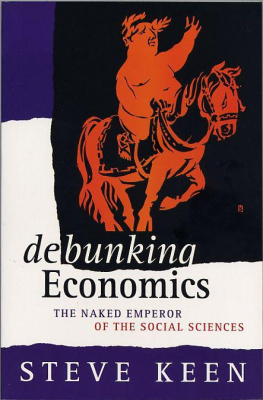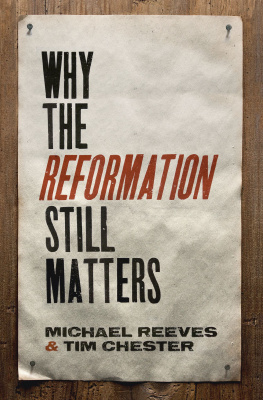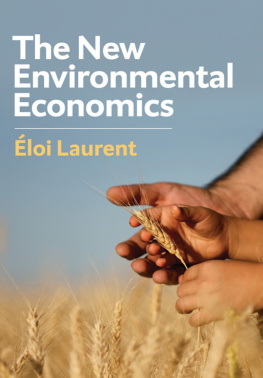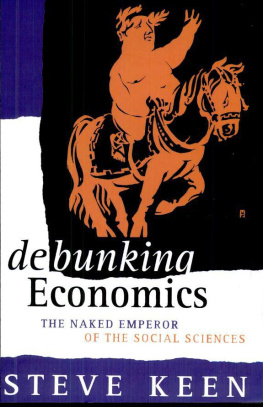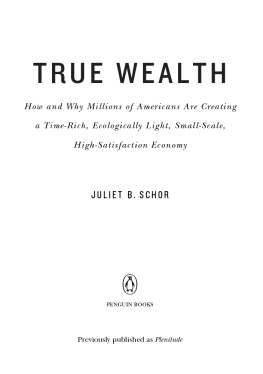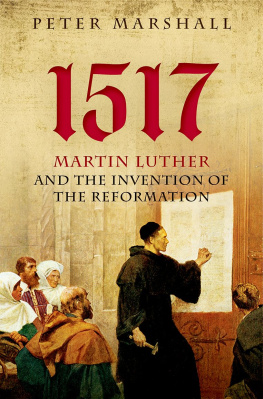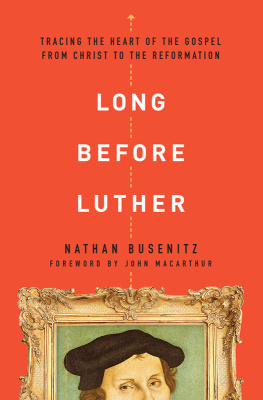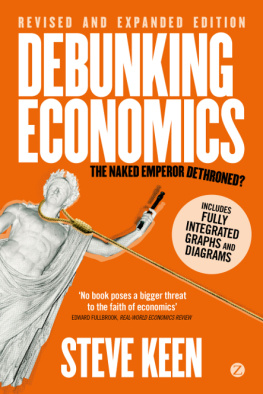Table of Contents
List of Tables
- Chapter 2
- Chapter 4
List of Illustrations
- Chapter 2
- Chapter 3
- Chapter 4
- Chapter 6
Guide
Pages
The New Economics
A Manifesto
Steve Keen
polity
Copyright Page
Copyright Steve Keen 2022
The right of Steve Keen to be identified as Author of this Work has been asserted in accordance with the UK Copyright, Designs and Patents Act 1988.
First published in 2022 by Polity Press
Polity Press
65 Bridge Street
Cambridge CB2 1UR, UK
Polity Press
101 Station Landing
Suite 300
Medford, MA 02155, USA
All rights reserved. Except for the quotation of short passages for the purpose of criticism and review, no part of this publication may be reproduced, stored in a retrieval system or transmitted, in any form or by any means, electronic, mechanical, photocopying, recording or otherwise, without the prior permission of the publisher.
ISBN-13: 978-1-5095-4528-5
ISBN-13: 978-1-5095-4529-2 (pb)
A catalogue record for this book is available from the British Library.
by Fakenham Prepress Solutions, Fakenham, Norfolk NR21 8NL
The publisher has used its best endeavours to ensure that the URLs for external websites referred to in this book are correct and active at the time of going to press. However, the publisher has no responsibility for the websites and can make no guarantee that a site will remain live or that the content is or will remain appropriate.
Every effort has been made to trace all copyright holders, but if any have been overlooked the publisher will be pleased to include any necessary credits in any subsequent reprint or edition.
For further information on Polity, visit our website: politybooks.com
Figures and tables
Figures
Money enables the butter maker to buy a gun without the gun maker having to want butter
The State as the conduit for fiat money transfers where money is the States liability and physical gold its asset
Modelling the initiation of a monetary economy in Minsky
Growth of coins and the economy from an initial minting of 1,000 coins
The fundamental monetary operations of the government
US government debt and deficits over the past 120 years
US unemployment and inflation 19601990
The relationship between credit and unemployment
Private debt and credit in the USA since 1834
The banking sectors view of a mixed fiat-credit economy
An integrated view of government deficits and private sector credit
Margin debt and the stock markets cyclically-adjusted price-to-earnings ratio (CAPE) since 1910
Accounting for a Modern Debt Jubilee
Change in household credit and change in house prices (correlation 0.64)
The cyclical interaction of grass and cows
A predator-prey model in Minsky, using sharks and fish
Lorenzs model of aperiodic cycles in the weather
The Keen-Minsky model and the intermittent route to chaos
Declining cycles in employment and inflation, while private debt rises
The basic principle of a heat engine: Work can be done if TH > TC
The correlation between change in global energy consumption and change in global GDP is 0.83
A simple energy-based model with resource depletion and waste production
Estimates of the total impact of climate change plotted against the assumed climate change
Simple population growth as an integral equation in Minsky
Tables
Economic performance of major periods in post-Second World War USA
A Moore Table showing expenditure IS income for a three-sector economy
The Moore Table for Loanable Funds
The Moore Table for bank-originated money and debt
Magnitude of credit and duration of negative credit in the USAs major economic crises
Extract from Nordhauss table 5: breakdown of economic activity by vulnerability to climatic change in 1991 US$ terms
Dedication
Dedicated to my wife Nisa, whose Buddhist grounding in the present keeps me sane as I contemplate the future facing both humanity, and the biosphere that humanity has so severely damaged.
Why this manifesto?
Even before the Covid-19 crisis began, the global economy was not in good shape, and neither was economic theory. The biggest economic crisis since the Great Depression began late in the first decade of the twenty-first century. Called the Global Financial Crisis (GFC) in most of the world, and the Great Recession in the United States, it saw unemployment explode from 4.6 per cent of the US workforce in early 2007 to 10 per cent in late 2009. The S&P500 stock market index, which had boomed from under 800 points in 2002 to over 1,500 in mid-2007, crashed to under 750 by early 2009. Inflation of 5.6 per cent in mid-2008 turned into deflation of 2 per cent in mid-2009.
The US economy recovered very slowly, under the influence of an unprecedented range of government interventions, from the Cash for Clunkers scheme that encouraged consumers to dump old cars and buy new ones, to Quantitative Easing, where the Federal Reserve purchased a trillion-dollars-worth of bonds from the financial sector every year, in an attempt to stimulate the economy by making the wealthy wealthier.
The crisis, and the sluggish recovery from it, surprised both the economists who advise governments on economic policy, and the academics who develop the theories and write the textbooks that train new economists. Not only had they expected a continuation of the boom conditions that had preceded the crisis, they in fact believed that crises could not occur.
In his Presidential Address to the American Economic Association in January 2003, Nobel Prize winner Robert Lucas declared that crises like the Great Depression could never occur again, because Macroeconomics has succeeded: Its central problem of depression prevention has been solved, for all practical purposes, and has in fact been solved for many decades (Lucas 2003, p. 1). Just two months before the crisis began, the Chief Economist of the Organization for Economic Cooperation and Development (OECD), the worlds premier economic policy body, declared that the current economic situation is in many ways better than what we have experienced in years, and predicted that in 2008, sustained growth in OECD economies would be underpinned by strong job creation and falling unemployment (Cotis 2007, p. 7, emphasis added). In the depths of the crisis, George W. Bushs Chief Economic Advisor Edward Lazear argued that, because the downturn had been so deep, the recovery would be very strong (Lazear and Marron 2009, Chart 1-9, p. 54). He was bitterly disappointed by the actual outcome, which was the slowest recovery from an economic crisis since the Great Depression itself.
How could economists be so wrong about the economy?
They could be excused their failure to see the Great Recession coming if the crisis were something like Covid-19, when a new pathogen suddenly emerged out of China. As long ago as 1995, Laurie Garrett declared that such a plague was inevitable (Garrett 1995). But predicting when the pathogen would emerge, let alone what its characteristics would be, was clearly impossible. However, the epicentre of the Great Recession was the US financial system itself: the crisis came from inside the economy, rather than from outside. Surely there were warning signs? As Queen Elizabeth herself put it when she attended a briefing at the London School of Economics in 2008, If these things were so large, how come everyone missed them? (Greenhill 2008).



